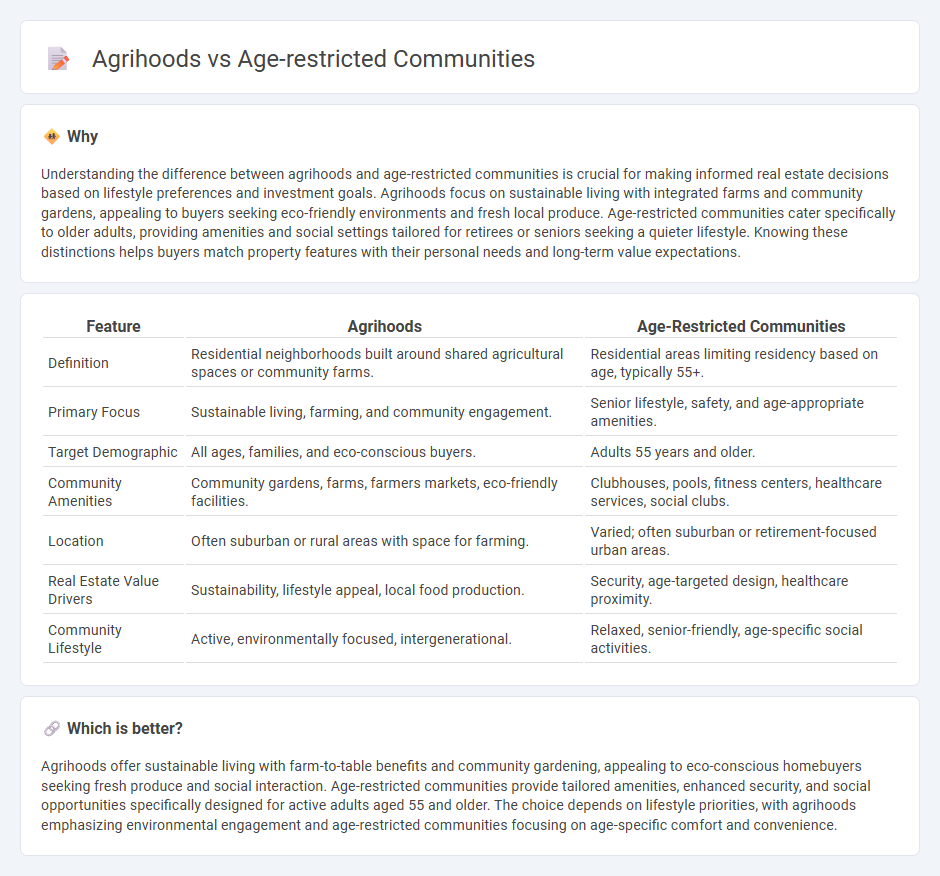
Agrihoods integrate residential living with sustainable agriculture, offering community gardens, fresh farm-to-table produce, and green spaces that promote an eco-friendly lifestyle. Age-restricted communities cater to active adults, usually 55+, providing amenities and social activities tailored to senior living. Explore the distinct benefits and lifestyle options these unique real estate developments offer.
Why it is important
Understanding the difference between agrihoods and age-restricted communities is crucial for making informed real estate decisions based on lifestyle preferences and investment goals. Agrihoods focus on sustainable living with integrated farms and community gardens, appealing to buyers seeking eco-friendly environments and fresh local produce. Age-restricted communities cater specifically to older adults, providing amenities and social settings tailored for retirees or seniors seeking a quieter lifestyle. Knowing these distinctions helps buyers match property features with their personal needs and long-term value expectations.
Comparison Table
| Feature | Agrihoods | Age-Restricted Communities |
|---|---|---|
| Definition | Residential neighborhoods built around shared agricultural spaces or community farms. | Residential areas limiting residency based on age, typically 55+. |
| Primary Focus | Sustainable living, farming, and community engagement. | Senior lifestyle, safety, and age-appropriate amenities. |
| Target Demographic | All ages, families, and eco-conscious buyers. | Adults 55 years and older. |
| Community Amenities | Community gardens, farms, farmers markets, eco-friendly facilities. | Clubhouses, pools, fitness centers, healthcare services, social clubs. |
| Location | Often suburban or rural areas with space for farming. | Varied; often suburban or retirement-focused urban areas. |
| Real Estate Value Drivers | Sustainability, lifestyle appeal, local food production. | Security, age-targeted design, healthcare proximity. |
| Community Lifestyle | Active, environmentally focused, intergenerational. | Relaxed, senior-friendly, age-specific social activities. |
Which is better?
Agrihoods offer sustainable living with farm-to-table benefits and community gardening, appealing to eco-conscious homebuyers seeking fresh produce and social interaction. Age-restricted communities provide tailored amenities, enhanced security, and social opportunities specifically designed for active adults aged 55 and older. The choice depends on lifestyle priorities, with agrihoods emphasizing environmental engagement and age-restricted communities focusing on age-specific comfort and convenience.
Connection
Agrihoods and age-restricted communities share a growing trend of integrating lifestyle preferences with residential planning, focusing on wellness and community engagement. Agrihoods provide sustainable farming and green spaces, which appeal to older adults seeking active, health-conscious living environments. Age-restricted communities often incorporate agrihood elements to enhance social interaction, promote outdoor activities, and support local food production, creating a holistic living experience tailored to seniors.
Key Terms
Demographics
Age-restricted communities primarily attract retirees and older adults aged 55 and above, fostering a quieter, low-maintenance lifestyle with amenities tailored to senior needs. Agrihoods draw a diverse demographic, including young families and professionals, who prioritize sustainable living, local food production, and community interaction around shared agricultural spaces. Explore how these distinct demographics influence the culture and development of these innovative residential concepts.
Zoning
Age-restricted communities enforce zoning laws that limit residency to individuals above a specific age, typically 55 and older, creating exclusive environments tailored to active adults and retirees. Agrihoods integrate residential zoning with agricultural land use, promoting sustainable living by combining homes with community farms and green spaces that support local food production. Explore the zoning distinctions and benefits of each community type to determine which lifestyle suits your needs best.
Amenities
Age-restricted communities typically feature amenities tailored to seniors, such as golf courses, clubhouses, fitness centers, and social activity rooms designed for a mature lifestyle. Agrihoods emphasize farm-to-table living with amenities like community gardens, orchards, farmers' markets, and walking trails that promote sustainable and health-conscious practices. Discover more about how these distinct amenities influence lifestyle choices within each community.
Source and External Links
Age-restricted community - Wikipedia - An age-restricted community is a residential area, often gated, designed to limit residency primarily to older adults, usually setting a minimum age of 55, with at least 80% of residents meeting this requirement; these communities often feature amenities and activities catering to active adults.
Are 55+ Communities Legal? Everything You Need to Know - Legally, age-restricted communities comply with the Housing for Older Persons Act (HOPA), which requires 80% of homes to have at least one occupant aged 55 or older, clear age restrictions in marketing, and age verification processes to maintain legal status.
Senior 55+ Communities - Davis-Stirling.com - Senior communities must comply with federal and state laws such as HOPA that allow age restrictions despite fair housing laws; typically, 80% of units must be occupied by someone 55 or older, and residents under this age can live only if linked to a qualifying senior resident under specific conditions.
 dowidth.com
dowidth.com